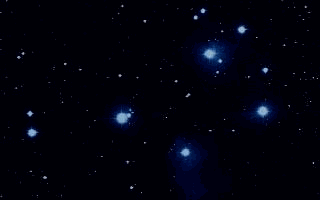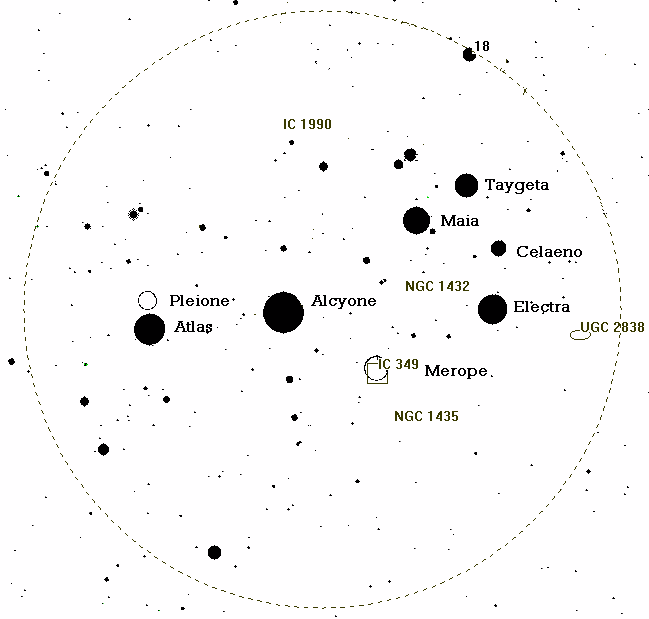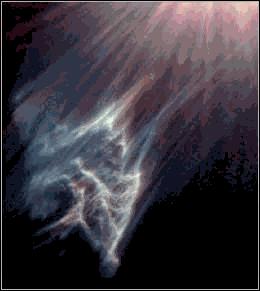The Pleiades Rising
Jack Kramer
The Pleiades open cluster (M45) ranks as one of the most familiar sights in the fall and winter; it's seen well up in the sky on early winter evenings. It happens to be one of the two Messier objects that was not listed in the NGC or IC catalogs, so while we know it by its common M45 designation, its alternate catalog number is Melotte 22 (Mel 22). As is typical of open clusters, the Pleiades is a fairly young object in astronomical terms, only about 80 million years old.
A casual observer should be able to spot five or six Pleiads with the naked eye. However, those who exert special effort can see many more. During the wee hours of a morning in September 1987, under dark skies at the Groezinger farm in far western Illinois, Greg Lutes made a concerted effort to locate Pleiads sans telescope. Here is an excerpt from his report.
"Without using my scope or binoculars, I began to observe the Pleiades. The first five stars were quickly identified - they were the four that form the square, plus the bottom left one (when facing east). The sixth one wasn't too difficult either - it was the star above the upper left one of the square. From this point, I just kept looking at the group of stars directly, then with averted vision, and back again. Over the course of about 20 to 25 minutes, stars seemed to blink in and fade out, some well defined, others vaguely. ... The next night at home I began to wonder how many stars of the Pleiades I had seen. I got out my sketch and counted; to my amazement, I had plotted out 15 stars! I dug out Burnham's Celestial Handbook to verify the stars' positions...and they matched!"

A few other naked eye observers have actually seen more than fifteen Pleiads, but our own "Eagle-Eye" Lutes ranks right up there. The late Walter Scott Houston referred to Greg's feat in one of his articles in Sky & Telescope, citing it as a good example of a methodical approach to naked eye observing.
Of course, binoculars or a telescope will reveal many more stars. The Pleiades is one of those deep sky objects that benefits from a low-powered, wide-field view. With too much magnification, it loses a great deal of its glamour and appears as simply a few bright stars.
In photographs, the whole Pleiades area is awash in blue-colored nebulosity, which indicates that this is a reflection nebula being lighted by the stars, rather than emitting radiation of its own. Under a dark sky, even a modest-sized telescope should reveal some nebulosity, primarily around the star Merope. Of course, the blue color shows up only on the photographs. Sometimes the optics of your telescope will throw up scattered light around bright stars, so don't confuse that with the nebulosity. A way to test this is to move the star just outside the field of view; if you still see a faint, irregular-shaped glow in that area, then you are probably seeing nebulosity.
The following chart is from the Guide program and includes the common names of major stars in the cluster. NGC 1435 is the largest nebulosity around Merope; it's also known as Tempel's Nebula. NGC 1432 is the nebulosity surrounding the star Maia. Most of the brightest stars show up with background reflection nebulosity on photographs, though it is faint and difficult to see visually. These patches of nebulosity are also known as Van den Bergh 20, 21, 22, and 23 around Electra, Maia, Merope, and Alcyone, respectively.

Now here is a couple of challenging objects in the same field as the Pleiades. UGC 2838 is a galaxy of magnitude 17.8, which is clearly beyond the visual reach of our telescopes. But what about a CCD? IC 1990 is shown as an "unknown" type of deep sky object in the Guide program; in Palomar Digital Sky Survey images or visually I have not been able to detect any object at this location. Possibly it may be a spurious classification in the Index Catalog.
The following Hubble Space Telescope image shows tufts of nebulosity only 30 arcseconds from Merope. But the gas and dust enveloping the stars are not the remnants of their birth. The cloud just happens to be passing by, and this part of it is being eroded by the strong radiation of Merope, only .06 light-year away. E. E. Barnard discovered some of these parts of the Merope cloud in the 19th century. This is now designated as IC 349, and also carries the name "Barnard's Merope Nebula".

Finally, the Pleiades is one of those objects that serves particularly well as both a calendar and a clock. It's what could be called a "transition object" between the seasons. Many times I've been out observing during the summer when someone will say, "It must be getting late...there's the Pleiades rising".





